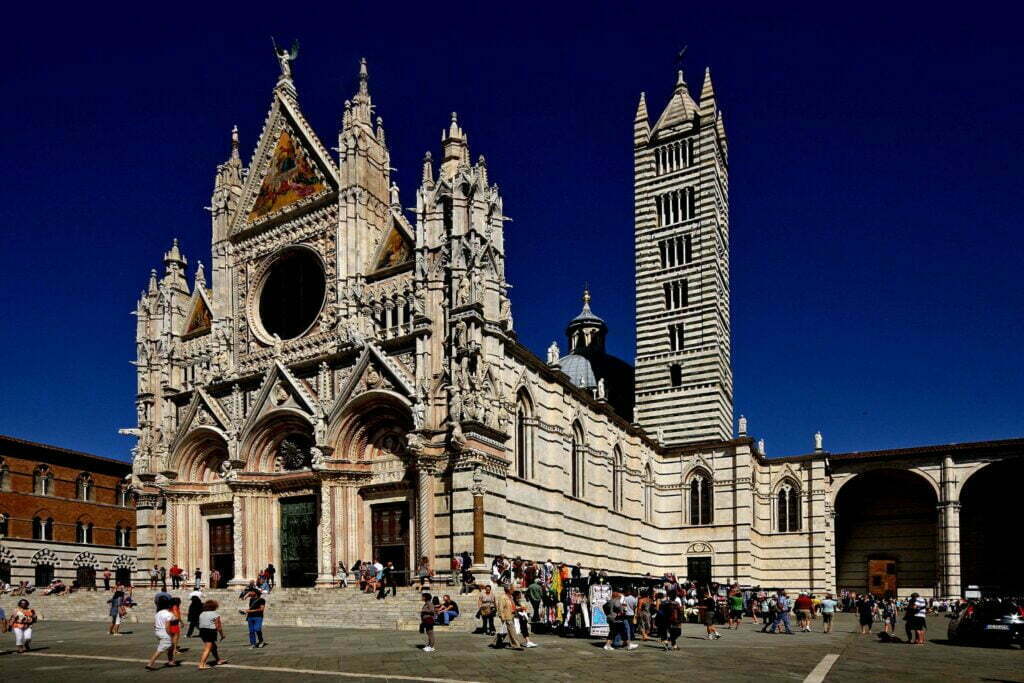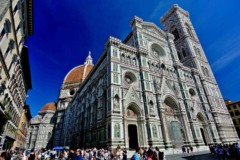Siena City is about 30 miles (48 km) south of Florence. It is in the Toscana or Tuscany region of central Italy. It became a UNESCO World Heritage Site in 1995. Before Florence took over in the 13th and 14th centuries, the Historic Centre of Siena was an important place in history because it was a center for business and banking.
Where is Siena Italy
Siena was built on the site of an Etruscan village, which became the Roman city of Sena Julia. This colony disappeared, but the Lombard kings made the new Siena that grew up in its place very successful.
Siena Italy History
In the 12th century, Siena became a town that took care of itself. Because of economic competition and territorial disputes with neighboring Florence, which was anti-imperial or Guelf, Siena became the center of pro-imperial Ghibellinism in Tuscany. The Sienese army was at its strongest on September 4, 1260, when they beat the Florentines at the Battle of Montaperti. In the 1300s, Siena grew into a major banking center.
Siena couldn’t beat its rival, Florence, which had been around for a long time. The empire’s cause got weaker, and the popes limited the Ghibelline merchants’ ability to make money in Siena. Soon after that, Siena changed its name to Guelf, and the Ghibelline nobility lost power.
At the beginning of the 1300s, the city was hurt by wars, famines, and Italy’s overall economic decline. Also, when it started in 1348, the Black Death did a lot of damage to the city. There were fights between nobles and merchants over who had the most power.
The Guelf-Ghibelline feud ended, but the people didn’t do much to make Siena safer. Even though the people of Siena had a lot of problems, they still built beautiful churches, palaces, towers, and fountains for their city.
Siena Italy Facts
After the Black Death, Siena’s economy and morals went downhill for many years. People became more religious at this time. During this time, Catherine and Bernardino, two well-known saints, were born in the city. Siena kept its independence in the 1500s, but its economy didn’t change much.
Exiled aristocrat Pandolfo Petrucci took over in 1487 and ruled harshly until his death in 1512. His family kept him in power until 1524, even though the French and the Spanish attacked. In 1555, Siena lost a long and brave battle to the Spanish. Philip II of Spain gave the city to Florence two years after that.
Historic Centre of Siena
In 1861, Siena and the rest of Tuscany were added to the Kingdom of Italy. Around the 16th century, most building stopped in Siena, and the most recent building was done outside the city walls. So, the city’s history has been preserved, and Siena is still mostly a town from the Middle Ages.
The walls and gates of the city center are made up of old buildings, palaces, and small streets that wind around each other. Most of Siena’s activities take place in the Piazza del Campo, a large, shell-shaped area in the middle of the city. A lot of people go to Siena to see the famous horse races called the Corsa del Palio.
These races happen twice a year in the Piazza del Campo, where there are also lots of other fun events. The civil government is run out of the big Public Palace. It was built from 1297 to 1310 and faces the Piazza. Inside the public palace are paintings by some of Siena’s best artists, like “Maestà” by Simone Martini and the frescoes by Ambrogio Lorenzetti.
The palace also has the Gaia Fountain, which is one of Jacopo Della Quercia’s best fountains and was made in Siena. On one side of the Public Palace is the Mangia Tower, which was built between 1338 and 1348. It is 334 feet (102 meters) tall and has a thin bell tower. The palaces of the Tolomei, Buonsignori, Sansedoni, and Salimbeni are also very nice buildings in the city.
Siena Cathedral
The large cathedral in Siena was built in the Romanesque style in the 1100s. It was changed into one of the best examples of Italian Gothic in the 13th century. Inside the church, the walls and columns are made of black and white marble, and Domenico Beccafumi made beautiful patterns in the marble floor.
The frescoes in the Piccolomini Library were done by Pinturicchio. The cathedral is right next to this one. In 1495, Cardinal Francesco Piccolomini started it. He went on to become Pope Pius III. In the Church of San Giovanni is the cathedral’s crypt. It has a lovely baptismal font with bas-reliefs by Jacopo Della Quercia, Donatello, and Lorenzo Ghiberti.
Ambrogio Lorenzetti and Sassetta paintings can be seen in Siena’s “Buonsignori Palace,” “Public Palace,” and “Museum of Works of the Duomo.” The famous “Maestà,” painting by Duccio, which was made between 1308 and 1311 to remember the Sienese victory at Montaperti, is also kept at the second museum.
Is Siena Italy Worth Visiting
During World War II, Siena was lucky that nothing bad happened to it. At the moment, it is an archbishopric and a beautiful, charming town in the country. In the year 1240, the University of Siena began. There aren’t many small businesses in the city. Even though Florence has a road, it is not on a major national highway or train line.
People come to Siena because of its wealth of art and its medieval buildings. It’s also a market town for the farms in the surrounding countryside. They raise animals, grow grains, make olive oil, and make wines, which is the most important thing they do. Its Chianti wine is one of Italy’s most famous wines.




